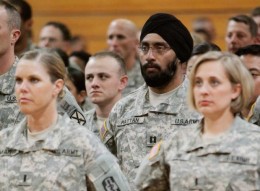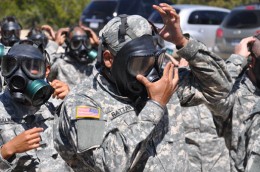((The following article appeared in the Fall 2010 issue of the Wright State University Magazine.))

U.S. Army Capt. Tejdeep Singh Rattan (center), wearing turban, stands with other graduates during a U.S. Army officer basic training graduation ceremony at Fort Sam Houston in San Antonio in March. Capt. Rattan is the first Sikh allowed to complete officer basic training while wearing the traditional turban and full beard since 1984.
When Captain Tejdeep Singh Rattan, ’01 and ’05, became a U.S. Army officer on March 22, 2010, he made American military history as the first Sikh officer to serve in the Army in more than two decades.
He also made headlines as images of him standing among the ranks of soldiers in standard-issue fatigues—donning his unshorn beard and distinct black turban—during the officer graduation ceremony at Fort Sam Houston spread across the globe via CNN, The New York Times, and Google. The next day, CNN named him “Most Intriguing Person of the Day.”
Rattan earned a Bachelor of Science in Biomedical Engineering from Wright State in 2001, then graduated with his Master of Science in Biomedical Engineering in 2005. He also earned an MBA.
When Rattan graduated from the Army’s nine-week basic officer training with the “articles” of his Sikh faith—unshorn hair and beard and turban—intact, he overcame a barrier that has essentially kept Sikhs out of the Army since 1984.
“I am committed to being a good American. I’ve sworn my allegiance to this country, and now I serve it,” said Rattan, 31, a dentist assigned to serve in the dental corps at Fort Drum, N.Y. “I knew I needed to assimilate, but cutting my beard and showing my hair is not an option.”
An uncut beard and hair and turban are among required articles of the Sikh faith, keeping Sikhs in the natural state in which God created them.
Observant Sikhs had served in the Army since World War I, until 1984, when the Army eliminated an exception for Sikhs and others who wore conspicuous religious articles, according to the Army’s website. Their beards and turbans created safety hazards, the Army said.
Rattan wore his beard and turban throughout dental school and his participation in the military Health Professionals Scholarship program, but was told to ditch them before joining the officer corps.
A letter to Defense Secretary Robert Gates, signed by 49 members of Congress and backed by several Sikh organizations, helped persuade the Army to grant an exception in December 2009. The Army grants exceptions on a case-by-case basis, it says.
Rattan proved he could overcome the Army’s safety objections to the religious articles.
“The issue was fitting my Kevlar helmet over my large turban and properly fitting a gas mask on my face to create a tight seal,” he said.
At his own expense, he created a fatigue-color turban with the Army insignia and wears it in place of the Army patrol cap. Under the Kevlar helmet, he wears a “mini-turban.”
For the gas mask, Sikhs who had served in the Indian Army showed him how to create a seal using Vaseline. He then withstood 10 minutes in a gas chamber during the nuclear, chemical, and biological portion of his training, emerging triumphantly from the chamber.
“It was a challenge and I felt like a warrior,” Rattan said.
The “warrior-saint” at Wright State
Being a “warrior-saint” is ingrained in Sikh culture, in which a primary tenet of their faith is fighting injustice.
Sikhs have a rich history of military service going back 500 years in India, from where most Sikhs have emigrated, as well as other countries, such as the United Kingdom, according to the advocacy group United Sikhs.
For Rattan, being a warrior-saint means dedicating himself to countering bias and prejudice against Sikhs in the United States—a mission that started at Wright State in the wake of the 9/11 terrorist attacks.
In the months following 9/11, Sikhs across the United States were experiencing acts of violence as they were mistaken for members of the Taliban, because their beards and turbans resembled those of Osama bin Laden and Al-Qaeda followers.
“Sikhs were experiencing a case of mistaken identity,” Rattan said. “People don’t understand that we have nothing in common with Islamic extremists, and while Sikhs have been living in this country for decades, all of a sudden we were very visible.”
Rattan rallied with the local Sikh community to increase awareness of their faith and how they differ from the Taliban.
“One of the things I learned at Wright State is that change comes from the top,” he said.
So Rattan became president of the Asian Student Association in 2003, and with the help of the Asian/Hispanic/Native American center, organized the first Sikh Cultural Exhibition and celebrated the Sikh New Year, Vaisakhi. He also participated in Wright State’s annual Quest for Community conference, presenting on his faith with members of the Dayton-area Sikh community. Rattan was given a Graduate Student Achievement award in 2003.
During the 2004 International Friendship Affair, he demonstrated turban-tying, the artful process in which male Sikhs bind their hair in turbans. Students lined up for the chance to wear a turban, and some wore them all day to their classes.
That year Rattan also carried the American flag during the IFA’s ritual flag parade. “I was asked to carry the flag for India, but I said, ‘I’m an American, I’ll carry the American flag,’” he explained.
Serving in the Army to pay back the United States
Rattan was born in Amritsar in the Punjab state of India, Sikhism’s historic homeland and site of its holiest temple. Of the 1.5 million Indians in Amritsar, about 74 percent are Sikh.
He immigrated to the U.S. with his family at the age of 17, and is an American citizen.
“One of the stepping stones in my life was Wright State’s Dunbar Library reference department,” Rattan said. “They gave me a job and guidance during a time when I was not so serious. Ran Raider and Cheryl Lauricella made a huge impact.”
Raider, government and legal information coordinator for the University Libraries, said Rattan left a lasting impression on staff members during his six-year stint as a library student assistant.
“He was very dedicated, almost maniacal, about his studies. He always finished everything he said he was going to do. And his commitment to educating people about his faith is extraordinary,” Raider said. “He wanted people to understand who Sikhs are.”
Rattan’s joining the Army is his way of paying back and continuing to fulfill his missions of educating others about Sikhs and of serving mankind.
“The United States is one of the best countries in the world. It gave me an incredible education and a world of opportunity, and I have to pay that back. The way to do that is to serve,” he said. “And being a warrior-saint, that means serving in the Army.”
“I am trying to the best of my ability to get the message across about Sikhs,” Rattan said. “If what I do educates just one additional person, and they educate another person, then I can help create a better world for Sikhs.”


 Wright State named a Best for Vets College
Wright State named a Best for Vets College  Wright State’s Boonshoft School of Medicine receives full continuing accreditation from Liaison Committee on Medical Education
Wright State’s Boonshoft School of Medicine receives full continuing accreditation from Liaison Committee on Medical Education  Wright State supports deaf and hard of hearing community with Deaf Festival
Wright State supports deaf and hard of hearing community with Deaf Festival  Wright State students showcase scientific discoveries at annual research festival
Wright State students showcase scientific discoveries at annual research festival  Wright State medical students bring medicine to life for Mini University preschoolers
Wright State medical students bring medicine to life for Mini University preschoolers 